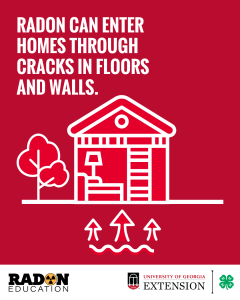
Heather N. Kolich, ANR Agent, UGA Extension Forsyth County
Radon is an odorless, colorless gas that kills nearly 21,000 people annually, including over 800 deaths in Georgia each year. Every January, the University of Georgia Radon Program urges Georgians to test for the presence of radon gas in their homes. People who order a test kit online before February 14, 2023, receive a $5 discount.
One in every 15 homes has high radon levels. Radon is a naturally occurring gas that comes from the breakdown of uranium in soil and rock. Granite rock often has high levels of uranium, which is part of the reason radon is a persistent problem in Georgia. The gas seeps out of the soil and rises up into homes through crawlspaces, foundations, and basements. Radon is the second leading cause of lung cancer in the U.S., right behind smoking, but it is the leading cause of lung cancer in non-smokers. People who smoke and are exposed to radon have a 10 times greater risk of developing lung cancer.
Fortunately, testing for radon gas is simple and inexpensive. Simply hang a short-term radon test kit in the lowest level of the home for three to seven days, then mail it to the laboratory for analysis. Homeowners receive results after the lab processes the test.
Tests can be purchased from the UGA Radon Program website or at a hardware store. Kits are usually $15, but Georgians who order a test kit at radon.uga.edu before February 14, 2023 and use the code NRAM2023 will receive a $5 discount.
If the radon level in your home is high, you can install a radon reduction system that reduces high levels of indoor radon to acceptable levels. The system most frequently used is a vent pipe and fan system that pulls radon from beneath the house and vents it to the outside.
Radon exposure from drinking water is primarily a concern in private wells. In Georgia, that risk is usually limited to the northern part of the state, where wells are often drilled into granitic crystalline rock aquifers. This is where the uranium that decays to radon can be found at higher levels. The average concentration of radon in water from granite aquafers is 8,000 picocurie (pCi) per liter, as compared to 200-600 pCi per liter for groundwater. When radon-containing water contacts air, the radon escapes into the air. Inside a home, radon can be released from water as a gas through the motion of the water during showering, washing dishes, and washing clothes. This is how homes can become contaminated with radon gas from well water that contains radon. Aeration treatment or granular activated carbon treatment at the point where water enters the home is highly effective at removing radon from water.
Radon testing is also available for water. Contact the Forsyth County Extension office at 770-887-2418 or Forsyth.extension@uga.edu to get a test kit.